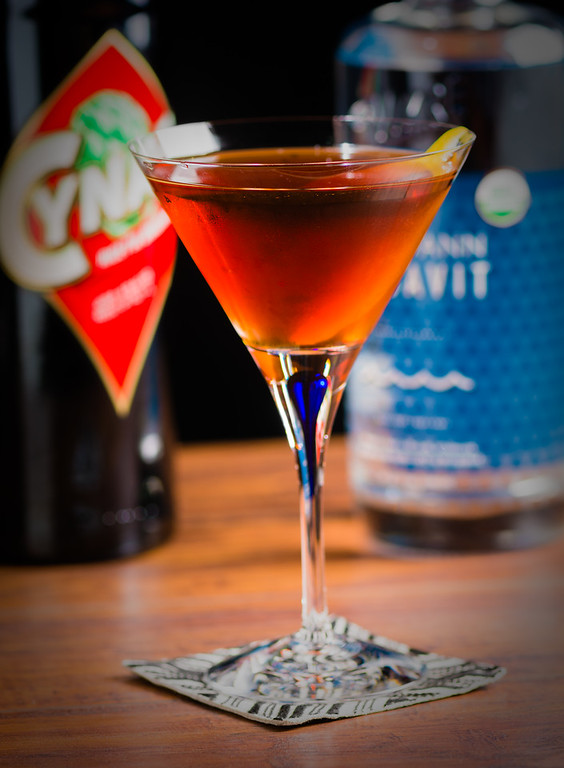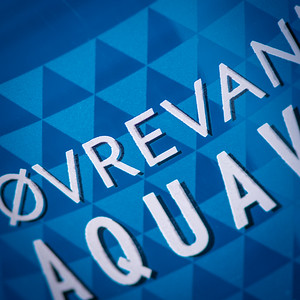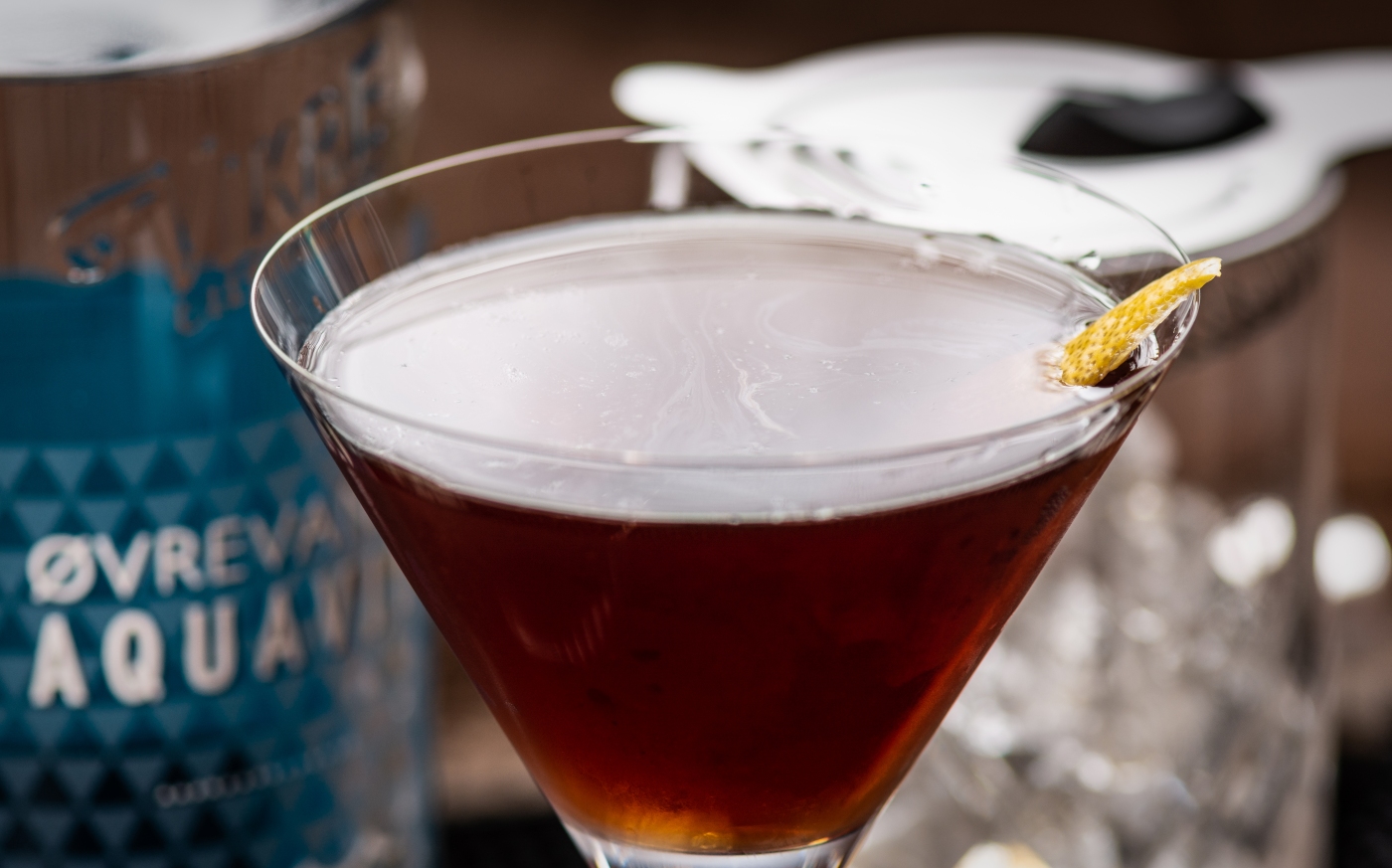It’s National Aquavit Week, and I just noticed that I have never published an aquavit cocktail here. There’s a reason for that: for the last ten years, I’ve mainly been focused on good cocktails with long histories, and there just aren’t any aquavit cocktails that fit that description.
Aquavit has always been a bit of a prickly customer, with big flavors foreign to the mainstream American drinking palate. But the American palate seems to be changing a bit — again.
Aquavit: gin’s cousin
Aquavit has historically been considered gin’s Scandinavian cousin. It starts out much like gin and vodka: a grain or potato distillate, usually clear. Then, like gin, it is infused with characteristic regional herbs and spices — in gin’s case, the hallmark flavoring is juniper; in aquavit, it’s northern Europe’s caraway or dill. Aquavit even has a history similar to gin’s, right down to the same type of heavy abuse in the 19th century that, a hundred years earlier, had earned English gin the epithet “Mother’s Ruin.” In both cases, regulation and taxation followed swiftly.
Aquavit’s defining flavors, caraway and dill, are not typically part of the American drinking palate, and are definitely in the love-it-or-hate-it category — strong, domineering flavors that can take over your palate in an instant. To complicate the spirit’s acceptance even further, many Scandinavian distillers tend emphasize anise notes, supporting the caraway with heavy doses of fennel and star anise. Others emphasize mint. It’s all fine and dandy if you like digestifs, but many find it difficult to acquire the taste.
As a result, aquavit is relatively rare in the American marketplace. Until a few years ago, you were unlikely to encounter it even in areas with strong German or Scandinavian heritage. Outside of cities like Minneapolis and Chicago, and, I would speculate, some of the port cities along the Midwestern Great Lakes, it seems that even Scandinavian pride wasn’t enough to assure aquavit’s place on the shelf.
Aquavit seems also to have been caught up in the generational divide that brought whiskey low in the 1970s and ’80s — in addition to being too aggressively flavored for the late-century white wine and vodka palate, it was perceived as Grandpa’s drink, hauled out of the freezer for shooters at every wedding, funeral, and religious holiday.
Aquavit has had a resurgence of interest in the US in the last few years. There are new small distilleries in regions associated with Scandinavian heritage — Chicago, Wisconsin, Minnesota, Colorado, and the Pacific Northwest — but its hallmark flavors of caraway and dill still aren’t part of the general American palate.
So aquavit remains a challenge to retailers, to drinkers, and to American bartenders. While the typical Scandinavian tradition is to drink aquavit as shooters, either warm or cold, Americans seem to be working it into their repertoire in the form of mixed cocktails, a more culinary approach to help us across the caraway, dill and anise divide.
Building the aquavit cocktail
That’s a slow process, and there aren’t yet many good aquavit cocktails. One of my favorites on the short list is Robert Hess’s Trident Cocktail.

Robert Hess, 2002
- 1 oz (30ml) dry sherry
- 1 oz (30ml) Cynar
- 1 oz (30ml) aquavit (Vikre Øvrevann)
- 1 dash peach bitters (Fee’s Peach Bitters)
- 1 dash orange bitters (Regan’s Orange Bitters #6)
Stir with ice until cold; strain into a chilled cocktail glass. Garnish with lemon twist.
Hess has tinkered with the formula over time. This version of the Trident starts with the version he published in his 2008 The Essential Bartender’s Guide.
In a way, it’s an amusing (and tasty) joke, a radical twist on the Negroni, with all ingredients substituted, as Hess puts it, “toward a more obscure ingredient.” The Negroni’s standard gin, vermouth and Campari are replaced by the more earthy caraway aquavit, sherry and bitter Cynar. And then there’s the peach bitters — not something everyone has in the pantry.
Hess recommends a decent amontillado sherry for the Trident. I’m fine with something like Dry Sack. In a no-sherry pinch, I’ve made the Trident with port, and it worked just fine — a bit sweeter and fruitier, but very drinkable. (Hess says the name “Trident” came from the idea that the three main ingredients all come from seafaring countries. Port is, of course, from famously seafaring Portugal, so I’m claiming that the substitution is not entirely subversive.)
 Though I live in Minneapolis, with its long-standing Scandinavian heritage, I’m only familiar with a handful of aquavits. My preference for the Trident is my regional Vikre Øvrevann, from beautiful Duluth, but I’ve also made excellent Tridents with North Shore Aquavit Private Reserve (Chicago) and Linie (Norway), all different is style, but all combining nicely with the sherry and Cynar.
Though I live in Minneapolis, with its long-standing Scandinavian heritage, I’m only familiar with a handful of aquavits. My preference for the Trident is my regional Vikre Øvrevann, from beautiful Duluth, but I’ve also made excellent Tridents with North Shore Aquavit Private Reserve (Chicago) and Linie (Norway), all different is style, but all combining nicely with the sherry and Cynar.
The artichoke amaro Cynar stands in for Campari in the Trident, completing the theme of earthy substitution for the more aggressive and bright-noted Negroni.
When Hess published the Trident in 2008, he added two dashes of Fee Bros. peach bitters; more recently, he has evolved the bitters component to one dash of peach bitters and one dash of orange bitters (he uses the popular combination of half Fee’s and half Regan’s orange bitters, sometimes referred to as “Feegan’s”).
I like the Trident because it softens the caraway attack, and complements it with other herbs and spices that round out the impression of herbality and richness in the drink. The nose is lemony, of course, from the lemon twist. The first sip is full of lemon oil and a prominent earthy herbality, driven mostly by the Cynar. The aquavit’s caraway is in the mid-palate, softened considerably by the complexity of the amaro and the nuttiness of the sherry. The bitters are pretty subtle in the Trident; I can’t really pick out notes of peach or orange.
The aquavit challenge
If you already have a bottle of aquavit that’s been sitting in the pantry since Uncle Sven visited ten years ago, I’d say take it down and give it a try. Even if you find that you’re still part of the “hate it” crowd, you may find that it’s brilliant as a cocktail ingredient, especially in a cocktail like the Trident, which has a complexity that covers some of the caraway’s aggression. In fact, I would consider the Trident something of a “gateway” cocktail for anyone sitting on the fence about aquavit.
If you’ve never experienced aquavit, there’s no better time than the present to give it a try. It’s still not a prominent spirit, but the renewed attention from bartenders and distillers across the country suggests that aquavit will not disappear, and that some of the cocktails being crafted today — like the Trident — may be the aquavit classics of tomorrow.
“Aquavit and the Trident Cocktail” at cold-glass.com : All text and photos © 2019 Douglas M. Ford. All rights reserved.

Great article!
We created Norden Aquavit in response to the bad wrap the category has been given throughout history. Our goal is to shine as a versatile cocktail ingredient while remaining complex and balanced as sipping spirit too. In honor of history we follow EU regulation for what defines aquavit. The backbone is classic caraway but we begin to break with tradition and really emphasize citrus among the other layers of flavor.
Please visit our website to learn more and feel free to reach out if you have any questions.
We love sharing this spirit and it’s rich history.
SKAL!
-Robyn and Summer Cleveland
(Founders)
http://www.nordenaquavit.com
I’ve enjoyed the occasional Linie aquavit for years. I’m a fan. I appreciate you posting something new… But I’m going to have to chase down some Sherry and Peach bitters this weekend.
Hi, Bob, yes, I enjoy Linie, too; its barrel aging does seem to make a difference, especially to “wood lovers” like me. It softens the edges, and adds a little vanilla and caramel flavor. I’ve always wondered if their schtick of sailing it to Australia and back really changes the flavor — no way to tell — but it makes a good story, and the aquavit is good sipping. Thanks for the note.
I came to appreciate Aquavit a few years ago once I found the Old Ballard Liquor Co. “Riktig” Aquavit, made in Seattle. I’m partial to the Caraway version. I enjoy it as a room-temperature sipped aperitif, but I love to use it as the base in a “Professer Jerry Thomas’ Improved Cocktail.” It’s my second-favorite base for that, after a really good Oude Genever.
Off to find some Cynar!
Hi, David, yes, a good aquavit would make a fine base for an “improved” cocktail. (For those new to Cold Glass, that would be an Old Fashioned with dashes of maraschino and absinthe.) I’ve tried aquavit with absinthe — in fact, a few drops of absinthe go quite nicely in the Trident — but never with maraschino; I’ll give it a try. Thanks!
New to Aquavit but heading to the store to give it a try. Are you familiar with either Brennivin or Aalborg (Jubilaeums or Taffel), which along with Linie, are the brands available here in Northern Virginia ABC stores? Otherwise, I’ll go with the Linie.
Hi, Kevin, being relatively new to aquavit myself, I’ve not had a chance to try either of those brands, though the Aalborgs are readily available here. Next on the list when my current supplies run low. Wish I could advise better, perhaps other readers can advise you in these comments? Thanks for asking.
WONDERFUL ARTICLE..GREAT JOB
such a cool blog..well done
As a Norwegian it’s fun to come across an American blog post on aquavit, great article.
I could add that, as with gin, few people drink it as a sipper. Many people drink it out of the freezer, which allows producers to be sloppy with their aquavits’ character since few will notice — shooting it ice cold as a chaser. So it could be that aversion against the spice combo could rather be a reaction to a lack of finesse to the specific product. But the concept has a great potential — just like craft gin has been around for a while now. If you ever find it, try a Gilde Non Plus Ultra, aged 12 years, as a sipper and you’ll probably see what I mean.
Hello, Arild, thank you for the additional aquavit insight. Ice cold shooters, yes, I can see how that could distort one’s understanding of the spirit. I’ll look for the aged Gilde, thanks for the advice. And thanks for reading Cold Glass.
Great writing Doug, on top of all else that the piece has to offer! I’m new to cocktail making – six months or so – and though aware of Aquavit and Cynar I’m yet to taste them. Now, I’m a big fan of Negroni and I remember reading somewhere that Cynar makes for an interesting alternative to Campari alongside gin and vermouth. Extending the scope of its use in combination with Aquavit gives me an extra bit of incentive to head down to Whole Foods Market and get myself a bottle of each (though the price of those ‘exotic’ concoctions, here in London, is a bit on a steep side).